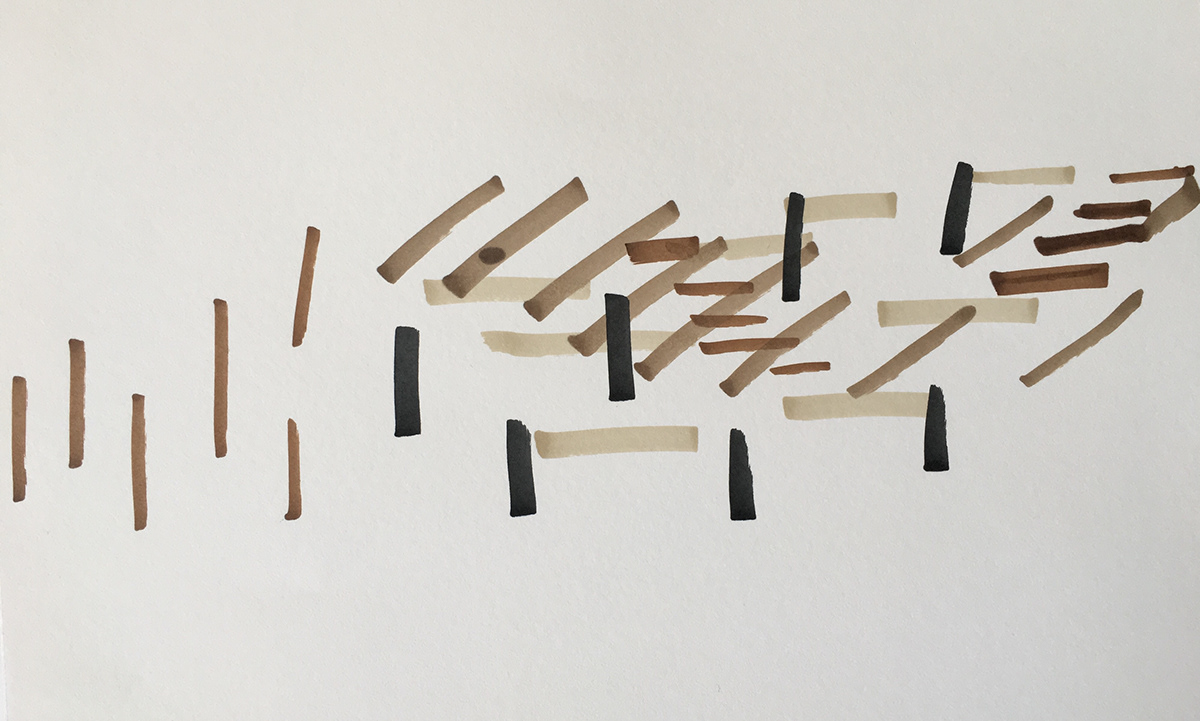ARCHITECTURAL HISTORY AND THEORY: ORIENTATIONS
ASSESSMENT TASK 03: SOUND AND AMBIENCE
Iannis Xenakis : Metastaseis (1953-1954) and Prithoprakta (1955-1956)
Iannis Xenakis was a Greek French architect, composer, music theorist and mathematician. He graduated from the Technological Institute of Athens and by 1947 he moved to Paris. Firstly, he worked as an assistant at Le Corbusier's architectural studio, but then he managed to collaborate on projects with him, such as the Sainte Marie de La Tourette. In 1958, he designed the Philips Pavilion in Brussels World Fair (see Figure 1).

Figure 1: Philips Pavilion, 1958, Brussels World Fair, Iannis Xenakis.
Xenakis was studying harmony and counterpoint, and composing. Olivier Messiaen, his teacher, told him to take advantage of being architect, Greek and his knowledge in mathematics and put that on his music. Through his studies with Messiaen, he discovered serialism and deeply understood the meaning of contemporary music.
Xenakis is mostly known as one of the leaders of modernism in music, since he became an extremely influential composer at the later 1950s and 1960s. He used mathematics and calculations as an organisation principle to create compositions. He experimented with these techniques and later they became the basic vocabulary of the 20th century avant-garde. He drew his music into a two-dimensional paper, but by giving it the illusion of a three-dimensional piece (see Figure 2). His most famous works are Metastaseis and Prithoprakta.
Metastaseis was the base for creating the Philips Pavilion. Its remarkable curved walls are translated as transcriptions of the aural curved surfaces of Metastaseis. Iannis Xenakis, by being both architect and composer, realised that the main difference between architecture and music is that architecture is that space can be experienced from all directions, whereas music only from one.

Figure 2: Drawing of Metastaseis by Iannis Xenakis.
In my work, I recorded the space as an abstract mathematical composition that follows the geometry of buildings. Specifically, by listening to Xenakis 's work Metastaseis, I realised that he creates music by gathering different sounds together that are not similar, but by arranging their order, a coherent piece is created. Therefore, I chose to record sounds that are different to each other and then ordering them thoughtfully.
Firstly, I recorded the sound that approaching or leaving trains make, but from a different distance each time to create levels. I used three different sounds of trains as my background, since every time the train was getting closer to or farer away from me, and when I was at an underground or open platform, it's sound had different scale.
Afterwards, I focused on sounds that are repetitive and clear in terms of the noise that exists in a busy city. I explored the less busy roads and went inside buildings and recorded sounds of footsteps, birds whistling, people pressing the traffic light button intensely etc.
To compose my final piece, I put the sound of the trains for the background in separate periods and then laid on top of each, the clears sounds. Moreover, I changed the repetition of each sound in some parts and make it louder or softer, too. In the last part of the recording, I added a period, where all the repetitive sounds are laid on top of each other.
To represent the recording in a drawing, I considered each four periods separately. I showed the main sound of the train by the black-grey tones, so when the sound was softer, I used a lighter tone. At the beginning, the sound of the train is really loud (see Figure 3), whereas at the third period is way softer (see Figure 4).

Figure 3: First period iteration. Drawing by Marya Yaqo.

Figure 4: Second and third period iteration. Drawing by Marya Yaqo.

Figure 5: Forth period iteration. Drawing by Marya Yaqo.
The repetitive sounds are shown by different shapes and colors. For instance, in the first period, the bird’s whistle is shown by the green circles, whereas the footsteps by brown thick lines (see Figure 6). In the last period, since new sounds are introduced in a chaotic way, they are laid in the whole period and some of them appear to connect with each other (see Figure 6).

Figure 6: Final drawing by Marya Yaqo.
Reference
http://www.boosey.com/pages/cr/composer/composer_main?composerid=2822&ttitle=Biography&ttype=BIOGRAPHY
https://en.wikipedia.org/wiki/Metastaseis_(Xenakis)
https://issuu.com/drawingcenter/docs/drawingpapers88_xenakis
https://jerwoodlibrary.wordpress.com/2016/09/12/james-choice-antonio-de-almeidas-score-of-iannis-xenakis-metastasis/
https://www.britannica.com/biography/Iannis-Xenakis
Figure 7: Recording by Marya Yaqo.

